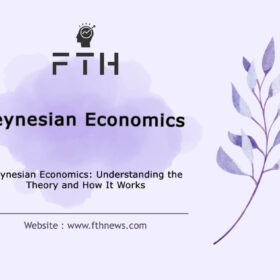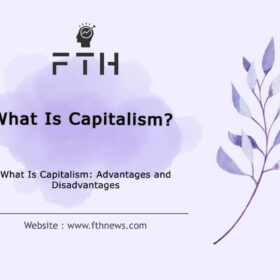
Invisible Hand Theory: What is it, benefits, criticisms, and role in market economies
In the field of economics, the concept of the invisible hand is used to coordinate individual interests with the interests of society.
This idea was first introduced by Adam Smith, who argued that in a free market system, individuals acting in their own self-interest are indirectly led to promote the common good.
The Invisible Hand Theory in Economics
The invisible hand theory is a concept in economics that suggests that markets and the economy are self-regulating and balanced, without the need for direct government intervention.
This theory was first proposed by Adam Smith in his book The Wealth of Nations.
Smith argued that when individuals act in their own self-interest, they are unintentionally led to promote the common good. This happens because the market forces of supply and demand act as an invisible hand to guide economic activity.
For example, if there is a high demand for a particular product, prices will rise, which will incentivize producers to make more of that product. This will lead to a decrease in demand and an increase in supply, which will eventually bring prices back down to a level that is both profitable for producers and affordable for consumers.
The invisible hand theory has been the subject of much debate and controversy over the years.
Some economists believe that the theory is correct and that markets can be relied upon to regulate themselves efficiently. Others argue that the theory is flawed and that markets often fail to produce desirable outcomes. For example, markets may not be able to adequately address problems such as pollution, climate change, and income inequality.
Despite its limitations, the invisible hand theory remains an important concept in economics. It helps us to understand how markets work and how they can be used to promote economic growth and prosperity.
Economists’ views on the invisible hand
Economists have interpreted the concept of the invisible hand in a variety of ways. Some economists, such as Paul Samuelson, have used the concept to justify free markets and limited government intervention. Others, such as Gavin Kennedy, have argued that the modern use of the concept as a symbol of free-market capitalism is at odds with the more nuanced view that Smith himself held.
The invisible hand theory has also been applied to other areas of society, such as politics and social welfare. Some economists have argued that the invisible hand can explain why cooperation and coordination can emerge even in the absence of central planning.
The debate between Kennedy and Klein highlights the complexity and evolution of the invisible hand theory. There is no single, universally accepted interpretation of the concept.
Key Concepts of the Invisible Hand
No need for government laws and price controls: The invisible hand theory argues that the market can regulate itself without the need for government intervention. This is because consumers and producers will naturally act in their own self-interest, which will lead to prices and quantities that are efficient and beneficial for everyone.
Organizations that pursue personal interests can contribute to the well-being of societies: The invisible hand theory also argues that organizations that pursue their own profits can indirectly benefit society. For example, a company that produces a new and innovative product may create jobs and boost economic growth.
Flow of wealth from capital owners to poorer strata: The invisible hand theory suggests that as the wealth of capital owners increases, some of this wealth may eventually trickle down to the poorer strata of society. This can happen through a variety of mechanisms, such as investment in new businesses, job creation, and philanthropy.
Private businesses find the most efficient use of capital funds: The invisible hand theory argues that private businesses are more efficient at allocating capital than governments. This is because businesses are motivated by profits, which encourages them to find the best ways to use their resources.
Free trade is beneficial: The invisible hand theory suggests that free trade is beneficial for all countries involved. This is because countries can specialize in producing goods and services in which they have a comparative advantage. This specialization leads to lower prices and higher quality goods for consumers.
It is important to note that the invisible hand theory is not without its critics. Some economists argue that the theory is too simplistic and that it ignores the many market failures that can occur. Others argue that the theory is unfair to the poor and that it leads to inequality.
Basic Principles of the Invisible Hand
1. Understanding and teaching personal benefit
Adam Smith believed that people are naturally self-interested, and that this self-interest can be harnessed to benefit society as a whole. He argued that if people are allowed to pursue their own interests freely, they will naturally produce goods and services that are in demand, and this will lead to economic growth and prosperity.
2. Small government
Smith believed that the government should play a limited role in the economy. He argued that the government should focus on providing essential services such as defense, public education, and infrastructure, and that it should avoid interfering in the free market.
3. Strong currency and economy based on free trade
Smith believed that a strong currency and a free market economy are essential for economic prosperity. He argued that a fixed exchange rate system, backed by gold, would help to stabilize the currency and make it easier for businesses to trade internationally. He also believed that free trade would allow countries to specialize in producing goods and services in which they have a comparative advantage, which would lead to lower prices and higher quality goods for consumers.
These three principles are the foundation of the invisible hand theory. Smith believed that if these principles are followed, the self-interest of individuals will lead to economic growth and prosperity for society as a whole.
It is important to note that Smith’s invisible hand theory is not without its critics. Some economists argue that the theory is too simplistic and that it ignores the many market failures that can occur. Others argue that the theory is unfair to the poor and that it leads to inequality.
How the Invisible Hand Works
The invisible hand is a metaphor used to describe the way that markets can self-regulate without government intervention. It is based on the idea that individuals, when acting in their own self-interest, will unintentionally produce outcomes that are beneficial for society as a whole.
For example, a butcher who sells meat for profit is motivated to sell high-quality meat at a fair price. If the butcher sells poor-quality meat, he will lose customers and go out of business. This means that the butcher has an incentive to produce and sell meat that meets the needs of his customers.
In this way, the invisible hand ensures that the market provides consumers with the goods and services they want at a price they are willing to pay.
The invisible hand works through the price system. Prices are signals that tell producers and consumers what goods and services are in demand and how much they are worth. Producers respond to high prices by increasing the supply of goods and services, while consumers respond to low prices by increasing their demand.
This process of supply and demand helps to ensure that the market reaches equilibrium, where the quantity of goods and services produced equals the quantity of goods and services demanded.
The invisible hand is not perfect. There are some market failures that can occur, such as monopolies and pollution. However, the invisible hand is a powerful force that helps to promote economic efficiency and prosperity.
Here is an example of how the invisible hand works in practice:
- A farmer produces wheat.
- A baker buys wheat from the farmer and uses it to make bread.
- A consumer buys bread from the baker.
Each of these individuals is acting in their own self-interest. The farmer wants to make a profit, the baker wants to make a profit, and the consumer wants to get the best bread possible at the lowest price.
Through the price system, the invisible hand coordinates the actions of these three individuals so that they all benefit. The farmer gets a fair price for his wheat, the baker makes a profit, and the consumer gets the bread they want at a price they are willing to pay.
The invisible hand is a powerful force that helps to make markets work efficiently and benefit society as a whole.
Criticisms of the Invisible Hand Theory
The invisible hand theory is a powerful concept, but it is not without its critics. Some economists argue that the theory is too simplistic and that it ignores the many market failures that can occur.
Others argue that the theory is unfair to the poor and that it leads to inequality.
Market failures
One of the main criticisms of the invisible hand theory is that it assumes that markets are perfectly competitive. However, markets often fail to be perfectly competitive, which can lead to problems such as monopolies, externalities, and information asymmetry.
Monopolies: A monopoly is a market where there is only one seller. Monopolies can charge higher prices and produce lower quality goods than would be produced in a competitive market.
Externalities: An externality is a cost or benefit that is imposed on third parties without their consent. For example, pollution is an externality because it harms people who are not directly involved in the production or consumption of the goods that cause the pollution.
Information asymmetry: Information asymmetry occurs when one party in a transaction has more information than the other party. For example, a car salesman may have more information about the condition of a car than a potential buyer.
Income inequality
Another criticism of the invisible hand theory is that it assumes that economic growth will benefit everyone equally. However, economic growth often leads to increased income inequality.
This is because the benefits of economic growth tend to accrue to the wealthy more than to the poor. For example, when the economy grows, the stock market often goes up, which benefits wealthy investors more than poor workers.
Moral hazard
The invisible hand theory also assumes that individuals will always act in their own self-interest. However, individuals may sometimes act in ways that are harmful to themselves or to others.
For example, people may choose to smoke cigarettes, even though they know that smoking is harmful to their health. This is an example of moral hazard, which occurs when people take risks because they believe that they will be protected from the consequences of those risks.
Addressing the criticisms
Economists have developed theories of government intervention that can help to correct market failures. For example, governments can regulate monopolies, internalize externalities, and provide information to consumers to reduce information asymmetry.
Governments can also use social safety nets to help to reduce income inequality. For example, governments can provide welfare payments to the poor and tax breaks to the middle class.
By addressing the criticisms of the invisible hand theory, economists have developed more nuanced theories of how markets work and how governments can intervene to improve economic outcomes for society as a whole.
Benefits of the Invisible Hand
The invisible hand theory has a number of benefits for market economies.
Efficiency: The invisible hand helps to ensure that markets are efficient. This means that goods and services are produced and consumed at the lowest possible cost.
Innovation: The invisible hand encourages innovation. This is because businesses are constantly trying to find new ways to produce goods and services more efficiently and cheaply.
Choice: The invisible hand gives consumers more choice. Consumers can choose from a wide variety of goods and services, and they can choose the goods and services that best meet their needs.
Prosperity: The invisible hand helps to promote economic prosperity. This is because efficient markets lead to lower prices and higher quality goods and services.
The Invisible Hand and Market Economies
The invisible hand theory is closely linked to market economies. Market economies are economies where individuals and businesses are free to produce and consume goods and services without government interference.
This theory suggests that market economies can be self-regulating. This means that markets can reach equilibrium without government intervention.
However, as we have discussed, markets often fail to be perfectly competitive. This means that government intervention may be necessary to correct market failures and promote economic efficiency and prosperity.
Despite the potential for government intervention, this theory remains a powerful concept for understanding how market economies work.
In conclusion, this theory is a complex and nuanced concept with both benefits and limitations. It is important to understand the criticisms of the theory in order to develop a more complete understanding of how markets work and how governments can intervene to improve economic outcomes for society as a whole.
FAQ
The main idea of the invisible hand theory quizlet is that individual self-interest can lead to beneficial outcomes for society as a whole.














